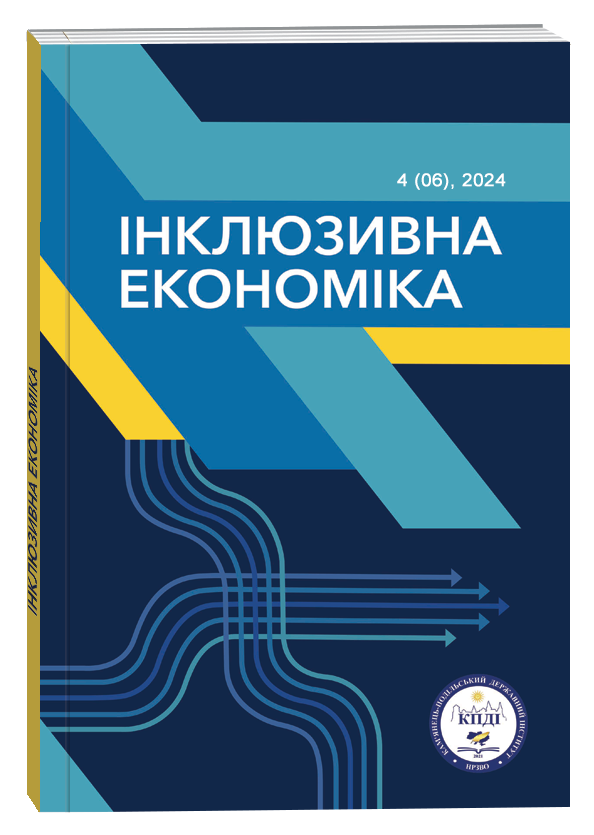THE ROLE OF STATISTICS IN DETERMINING THE EFFECTIVENESS OF INCLUSIVE CHILD DEVELOPMENT PROGRAMMES
DOI:
https://doi.org/10.32782/inclusive_economics.6-8Keywords:
inclusion, child development programs, effectiveness, statistics, evaluation, methodology, research, cooperation, resourcesAbstract
Introduction. Inclusion, both as a principle and practice, has become not only a strategic step in education and social development but also a symbol of the desire to build a fair and equitable society where every child has the opportunity to develop to their full potential. The essence of inclusive child development programs lies not only in providing access to education but also in creating conditions that ensure equal opportunities for learning and development, regardless of individual needs, limitations, or characteristics. However, assessing the effectiveness of these programs is a crucial and complex task that requires objective evaluation and analysis. In this context, the role of statistics becomes indispensable. Statistical methods enable not only the objective measurement and analysis of the results of inclusive child development programs but also the revelation of significant patterns that help identify effective and ineffective approaches. Systematic collection, processing, and interpretation of statistical data allow for identifying factors influencing the effectiveness of inclusive programs and determining directions for further improvement. This paper discusses the significance and importance of statistics in determining the effectiveness of inclusive child development programs, as well as examines specific methods and approaches that can be used for this purpose to identify optimal strategies for inclusive development and contribute to achieving their goals. The problem of the research lies in the need to explore how statistical methods and data analysis contribute to assessing the effectiveness of inclusive programs for child development. Despite the increasing implementation of inclusive education and developmental programs aimed at children with diverse needs, there is a lack of standardized and comprehensive statistical tools to objectively measure their success. This research aims to investigate how statistical indicators, such as academic performance, social integration, emotional well-being, and long-term outcomes, can be effectively used to evaluate the impact of inclusive programs. Additionally, the study will address the challenges in collecting, analyzing, and interpreting data from diverse educational settings, and how statistical approaches can inform better decision-making, resource allocation, and the refinement of inclusive practices to ensure equitable development opportunities for all children. Methods. Various scientific methods were applied during the research to deeply analyze and evaluate different aspects of this topic. The general scientific method was used for an overview of the topic and providing a general picture of inclusive programs. The method of combination allowed for creating a comprehensive system of the studied phenomena, considering information from various sources. The axiomatic method, particularly through deduction, was used to identify the fundamental principles underlying effective inclusive programs. The concluding method of combination combined different methods to create a complex understanding of the problem, its functions, and implementation methods, providing a complete methodological understanding of the role of methods in addressing this issue. Main research findings. The main research findings indicate that statistics play a crucial role in determining the effectiveness of inclusive child development programs. Through various statistical methods, a deep analysis of different aspects of programs was conducted, including academic achievements, social adaptation, emotional development, and resource availability. The results showed that inclusive programs, providing a wide range of support and individualized approaches, have significant potential to improve the quality of education and social development for children. Results. The research highlights the crucial role of statistics in assessing the effectiveness of inclusive child development programs. It identifies key statistical indicators, such as academic performance, social integration, emotional well-being, and long-term outcomes, which are essential for evaluating program success. The study also develops a comprehensive framework that integrates both qualitative and quantitative data, emphasizing the importance of regular monitoring and feedback. However, challenges in data collection, inconsistent reporting, and difficulties in isolating specific interventions were noted. The research demonstrates how statistical tools like regression analysis and longitudinal studies can guide informed decision-making, improve resource allocation, and enhance program design. Recommendations include standardized evaluation protocols, better data collection practices, and cross-sector collaboration to ensure continuous program improvement. Ultimately, the study advocates for evidence-based policies that prioritize inclusivity, ensuring equal developmental opportunities for all children. Conclusions. The conclusions of the research highlight several key findings and specific recommendations for further development of inclusive child development programs. Firstly, the necessity of further scientific research for continuous improvement and adaptation of programs to children's needs was emphasized. Additionally, the author recommends more active implementation of individualized approaches to learning, strengthening cooperation among educational stakeholders, ensuring adequate resource availability for inclusive programs, conducting systematic monitoring and evaluation using statistical methods, and emphasizing the creation of an inclusive environment that promotes the development of each child based on equal opportunities and support. These recommendations aim to provide optimal conditions for learning and development for children with various educational needs, including those with special needs.
References
Барков Я. Методи аналізу показників і тенденцій розвитку. Економіка України. 1999. № 8. С. 90–92.
Горкавий В.К. Використання методів математичної статистики в управлінні соціально-економічними процесами. Вісник ХНАУ. 2015. № 1. С. 129–139.
Дєгтяр А. Використання статистичних методів в процесі прогнозування наслідків державноуправлінських рішень. Вісник УАДУ. 2002. № 4. С. 47–51.
Колеснік В.І. Статистичне забезпечення регіонального управління: монографія. Київ : ДП «Інформ.-аналіт. Агентство», 2007. 475 с.
Опря А.Т. Методологічні засади використання статистичних методів в економічних дослідженнях: ідеї, пошуки, рішення. Вісник Полтавської державної аграрної академії. 2010. № 1. С. 172–178.
Опря А.Т. Методологічні особливості використання дисперсійного методу в аналізі й дослідженні економічних явищ і процесів: можливості й обмеження. Вісник Полтавської державної аграрної академії. 2010. № 4. С. 157–162.
Barkov Yа. (1999) Metody analizu pokaznykiv i tendentsiy rozvytku [Methods of analysis of development indicators and trends]. Ekonomika Ukrayiny – Ukraine economy, vol. 8, pp. 90–92.
Horkavyy V. K. (2015) Vykorystannya metodiv matematychnoyi statystyky v upravlinni sotsialʹno-ekonomichnymy protsesamy [The use of mathematical statistics methods in the management of socio-economic processes]. Visnyk KHNAU – KHNAU Bulletin, vol. 1, pp. 129–139.
Dyehtyar A. (2002) Vykorystannya statystychnykh metodiv v protsesi prohnozuvannya naslidkiv derzhavnoupravlinsʹkykh rishenʹ [The use of statistical methods in the process of forecasting the consequences of public management decisions]. Visnyk UADU – Bulletin of the Ukrainian Academy of Sciences, vol. 4, pp. 47–51.
Oprya A. T. (2010) Methodological features of using the dispersion method in the analysis and research of economic phenomena and processes: opportunities and limitations [Methodological features of using the dispersion method in the analysis and research of economic phenomena and processes: opportunities and limitations]. Bulletin of the Poltava State Agrarian Academy, vol. 4, pp. 157–162.
Kolesnik V. I. (2007) Statystychne zabezpechennya rehionalʹnoho upravlinnya: monohrafiya [Statistical support of regional management: monograph]. Kyiv: DP «Inform.-analit. Ahentstvo». (in Ukrainian)
Oprya A. T. (2010) Metodolohichni zasady vykorystannya statystychnykh metodiv v ekonomichnykh doslidzhennyakh: ideyi, poshuky, rishennya [Methodological principles of using statistical methods in economic research: ideas, searches, solutions]. Visnyk Poltavsʹkoyi derzhavnoyi ahrarnoyi akademiyi – Bulletin of the Poltava State Agrarian Academy. vol. 1, pp. 172–178.
Oprya A. T. (2010) Metodolohichni osoblyvosti vykorystannya dyspersiynoho metodu v analizi y doslidzhenni ekonomichnykh yavyshch i protsesiv: mozhlyvosti y obmezhennya [Methodological features of using the dispersion method in the analysis and research of economic phenomena and processes: opportunities and limitations]. Visnyk Poltavsʹkoyi derzhavnoyi ahrarnoyi akademiyi – Bulletin of the Poltava State Agrarian Academy. vol. 4. pp. 157–162.



